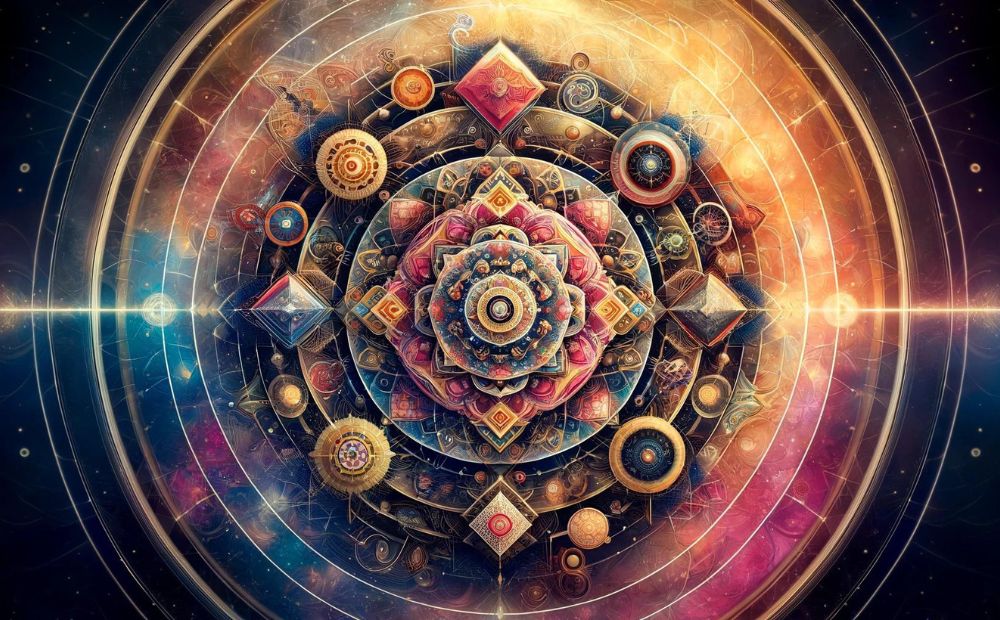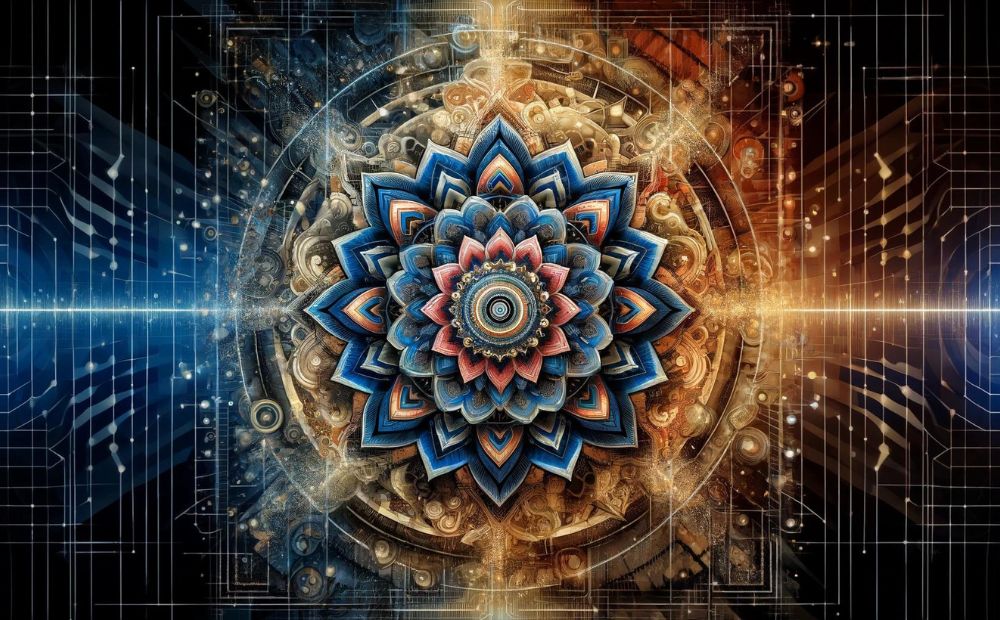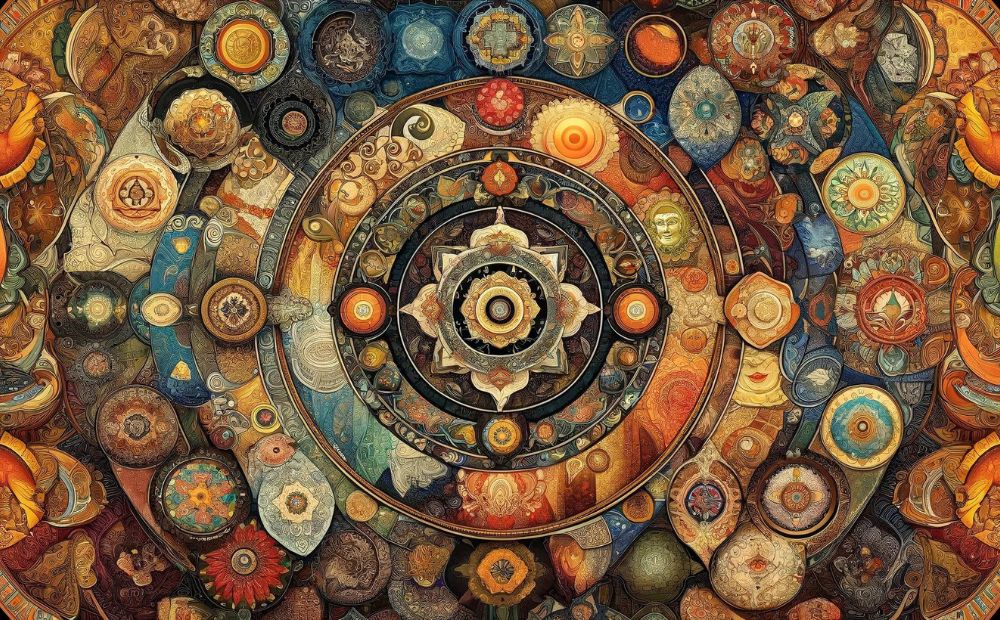Have you ever wondered about the story behind those mesmerizing, circular designs known as Mandalas? Well, let’s dive into their fascinating origins and uncover the roots of these symbols that have captivated human imagination for centuries.
First off, “Mandala” isn’t just a catchy name; it’s a word steeped in ancient history, coming from Sanskrit, an old language from India. It means “circle,” but oh, it’s so much more than that. Think of it as a circle that encompasses both the universe and the inner journey of the self. Pretty deep, right?
Our journey begins in India, the birthplace of Mandalas. They first appeared in Hindu and Buddhist traditions, serving not just as art but as a profound spiritual tool. These Mandalas were maps, of sorts, guiding the soul in meditation and leading it towards enlightenment. Imagine sitting down, focusing on a Mandala, and feeling a connection to the entire universe. That’s the power they hold.
But the story doesn’t end there. As Buddhism spread from India to other parts of Asia, so did the practice of creating Mandalas. They found a new home in countries like Tibet, China, and Japan, each culture adding its own unique flair to the tradition. It’s like how a recipe changes when it travels, picking up local flavors and ingredients along the way.
In Tibetan Buddhism, Mandalas took on an incredibly intricate form, often created with colored sand. Picture monks meticulously placing grains of sand for days or even weeks, crafting an elaborate, breathtaking design, only to wipe it all away upon completion. This act, deeply symbolic, reminds us of the impermanence of life and the beauty in letting go.
Isn’t it fascinating how a simple concept of a circle can unfold into such rich, complex traditions across cultures? Mandalas truly are a testament to the interconnectedness of human creativity and spirituality. So, the next time you see a Mandala, remember, it’s not just a pretty design; it’s a window into the soul of civilizations, a circle that connects us all.
The Spiritual Geometry of Mandalas: Circles, Squares, and Everything In-Between

Now that we’ve traced the roots of Mandalas back to their origins, let’s delve a little deeper into what makes them so spiritually significant. It’s all in the geometry – circles, squares, and a myriad of shapes that come together in a dazzling dance of symbolism.
At the heart of every Mandala is the circle, a shape that’s as infinite as the universe itself. It represents wholeness, unity, and the cycle of life. There’s something inherently soothing about a circle, don’t you think? It’s like looking at the horizon, where the sky meets the sea, and feeling that sense of endless possibility.
But a Mandala isn’t just a simple circle. Oh no, it’s a complex blueprint of the cosmos. Inside these circles, you’ll often find squares, triangles, and other geometric shapes, each adding their own layer of meaning. The square, for example, with its four sides, can symbolize the four cardinal directions or the earthly realm as distinct from the heavens.
Let’s talk triangles – these aren’t your ordinary geometry class figures. In Mandalas, an upward-pointing triangle might represent action and energy, while a downward-pointing one can signify spiritual insight. When these shapes interlock and overlap in a Mandala, they create a narrative, a story about the balance between the spiritual and the material, the inner and the outer.
What’s truly fascinating is how this symbolism isn’t just abstract. It’s meant to guide meditation and spiritual practice. Gazing upon a Mandala, with its geometric harmony, can help quiet the mind and lead it towards profound insights. It’s like each shape in the Mandala is a stepping stone, leading deeper into the mysteries of existence and the self.
And here’s the kicker: despite their ancient origins, the geometric principles of Mandalas still resonate today. Whether in the designs of modern buildings, logos, or even the layout of cities, the fundamental balance and symmetry of Mandalas continue to influence our world.
So, the next time you come across a Mandala, take a moment to appreciate not just its beauty but the geometric genius behind it. Each shape, each line, tells a story of the universe and our place within it, inviting us on a journey of discovery that’s as circular as the Mandala itself.
Mandalas Across Cultures: A Tapestry of Tradition and Transformation
In the high, mountainous regions of Tibet, Mandalas take on a sacred form that’s as visually stunning as it is profound. Tibetan Buddhists create Mandalas from colored sand, a practice that requires immense patience and concentration. Picture this: monks leaning over a platform, funneling grains of sand through tiny metal tubes with precision and dedication. The result? A vibrant, intricate Mandala that’s a feast for the eyes and the soul. But here’s the twist—the moment a sand Mandala is completed, it’s ceremoniously destroyed. This act is a profound reminder of life’s impermanence and the importance of not clinging to the material world. Talk about a lesson in mindfulness and letting go!
But the story of Mandalas doesn’t end in Asia. Let’s take a detour to the American Southwest, where the Navajo people have their own tradition of sand painting. Similar to Tibetan Mandalas, these are created with colored sand and are deeply spiritual. However, Navajo sand paintings serve as healing rituals rather than meditative tools. They’re meticulously crafted by medicine men during healing ceremonies, believed to summon the gods’ help in healing the sick. Though different in purpose, the parallels between Navajo sand paintings and Tibetan Mandalas underscore a universal human inclination towards creating sacred art from earth’s elements.
Traveling back across the ocean, we find echoes of Mandalic patterns in the stained glass of Gothic cathedrals and the intricate knots of Celtic art. Have you ever marveled at a Gothic rose window? Its symmetrical design radiates from the center, much like a Mandala, drawing the viewer’s gaze into a contemplative state. Similarly, Celtic knots with their endless loops reflect Mandalic themes of unity and eternity.
These cultural iterations of Mandalas show us that the desire to symbolize the cosmos and our connection to it is a universal human experience. From the sands of the Tibetan plateau to the stone of European cathedrals, the Mandala manifests in myriad forms, bridging worlds and weaving a shared narrative of human spirituality and creativity.
So, as we explore Mandalas across cultures, we’re reminded of the power of symbols to transcend language and geography, uniting us in our quest for understanding and spiritual connection. It’s a journey that celebrates not just the diversity of human expression, but the common threads that bind us all.
Mandalas in Contemporary Times: Modern Spirals of Tradition and Innovation

As we meander through the historical and cultural landscapes of Mandalas, it’s clear that their journey doesn’t halt in ancient times or distant lands. Fast forward to today, and you’ll find Mandalas pulsating at the heart of contemporary life, morphing into modern avatars that blend tradition with innovation.
In the realm of modern art, Mandalas have emerged from the shadows of temples and sacred texts to claim their spot on gallery walls. Artists, drawing inspiration from traditional Mandalas, infuse them with contemporary themes and techniques, creating works that resonate with today’s audiences. Imagine a Mandala reimagined with digital art tools, its geometric patterns swirling in vibrant, neon colors, or a three-dimensional installation inviting viewers into an immersive experience. These modern Mandalas bridge ancient spirituality with the present, reminding us that the search for meaning and connection is timeless.
But Mandalas aren’t just making waves in the art world. They’ve found a significant place in therapy and wellness, offering a peaceful harbor in the storm of modern life. Therapists often use Mandala drawing as a tool for meditation and self-exploration. Carl Jung, the Swiss psychiatrist, was one of the first to introduce Mandalas in a therapeutic context, viewing them as a means to access the unconscious and achieve personal wholeness. Today, coloring Mandalas is a popular stress-relief activity, believed to calm the mind and foster creativity. It’s fascinating to see how this ancient symbol serves as a bridge between the spiritual and psychological, providing a pathway to inner peace.
The digital age has also embraced Mandalas, transforming them into interactive experiences. From virtual reality meditations where users can create and explore their own digital Mandalas to apps that facilitate Mandala coloring, technology has expanded the ways in which we can engage with these ancient symbols. It’s a testament to the adaptability of Mandalas, showing that even in our fast-paced, tech-driven world, there’s a craving for the serenity and introspection they offer.
Mandalas have even stepped into the realm of social media, becoming a source of inspiration and community. Social platforms are awash with images of Mandalas, from intricately drawn designs to sand Mandalas being swept away, each post a reminder of the beauty and impermanence of life. Through hashtags and shares, the spirit of Mandalas spreads, connecting people across the globe in a shared appreciation of their beauty and depth.
In this way, Mandalas continue to spiral out from their ancient origins into the fabric of modern life, proving that their appeal is not bound by time or tradition. They are a vibrant, living expression of humanity’s quest for understanding, a geometric metaphor for life’s complexity and unity. As we navigate the challenges of the contemporary world, Mandalas remain a beacon, inviting us to pause, reflect, and find balance amidst the chaos.
The Process of Creating Mandalas: From Sacred Ritual to Modern Meditation

Diving into the creation of Mandalas offers an illuminating journey from ancient ritual to contemporary craft, revealing a process that is as varied and profound as the Mandalas themselves. This journey transcends mere artistry, embodying meditation, therapy, and personal expression across cultures and epochs.
In traditional settings, creating a Mandala is a sacred act, often accompanied by rituals and prayers. Imagine Tibetan monks engaging in a ceremonial dance before painstakingly assembling a sand Mandala, or a Navajo medicine man preparing for a healing ceremony through sand painting. These processes are deeply spiritual, with each color and symbol infused with intention and meaning. The act of creation is meditative, requiring patience, focus, and a deep connection to the spiritual dimensions the Mandala represents. It’s a form of moving meditation, where the creators immerse themselves in the moment, channeling their intentions into each grain of sand or brushstroke.
Transitioning to the modern context, the essence of creating Mandalas remains meditative, though the tools and settings might have evolved. Today, anyone can embark on this creative journey, no sand or temple required. With a simple piece of paper, a compass, and some colors, you can create your own Mandala, layering circles, squares, and petals into a design that resonates with your inner self. The beauty of this practice lies in its accessibility and adaptability; it’s as much at home in a quiet, personal space as it is in a community workshop or classroom.
Moreover, the therapeutic benefits of creating Mandalas have gained recognition in contemporary psychology. Drawing or coloring Mandalas can be a form of art therapy, offering a refuge from stress and anxiety. The repetitive motions and focus on patterns can lead to a meditative state, promoting relaxation and mindfulness. It’s a practice that doesn’t demand artistic skill but rather an openness to the experience and the emotions it may stir.
Community Mandalas take this a step further, bringing people together to co-create a shared piece. This collective process can be a powerful tool for building connections and fostering a sense of belonging. Whether in a classroom, a community center, or an online platform, participants contribute to a larger design, each piece reflecting an individual’s style yet harmonizing with the whole. The result is not just a visual spectacle but a testament to collaboration and unity.
From the meticulous rituals of monks to the quiet concentration of someone coloring in their living room, the process of creating Mandalas bridges worlds. It’s a practice that speaks to the universal human need for expression, connection, and tranquility. Whether as a spiritual discipline, a therapeutic exercise, or a communal activity, the creation of Mandalas continues to be a powerful medium for exploring the self and the universe, one circle at a time.
Mandalas and the Tapestry of Consciousness: Personal Journeys and Collective Insights
As we weave through the narrative of Mandalas, their role in shaping personal and collective consciousness emerges with vivid clarity. These intricate designs, far more than mere art, serve as mirrors reflecting our deepest selves and as bridges connecting us to the broader human experience.
Personal anecdotes abound, illustrating the transformative power of engaging with Mandalas. There are stories of individuals finding solace and strength in the creation and contemplation of Mandalas during times of turmoil and transition. For some, these patterns become a visual language through which they can articulate aspects of their journey for which words fall short. A person might begin drawing a Mandala as a form of meditation, only to discover layers of emotional healing and self-understanding unfolding with each concentric circle.
In educational settings, Mandalas have carved out a space as dynamic tools for learning and growth. Teachers report that incorporating Mandala activities in classrooms not only fosters creativity and concentration but also encourages a sense of calm and community among students. It’s a practice that transcends age, proving equally engaging and beneficial from young children to adults, illustrating the universality of its appeal.
The role of Mandalas in spiritual practices and mindfulness cannot be overstated. Across diverse spiritual traditions, Mandalas are employed as focal points for meditation, aiding practitioners in diving deeper into their inner worlds and connecting with the divine. The very act of focusing on a Mandala, whether in creation or contemplation, can facilitate a shift in awareness, opening up spaces of stillness and insight. It’s as if each Mandala serves as a portal, offering access to realms of consciousness that often remain unexplored.
Moreover, the collective dimension of Mandalas contributes to a shared spiritual and cultural heritage. In communities around the globe, Mandalas are a means of coming together, celebrating shared values, and fostering a sense of unity in diversity. Whether through community art projects, festivals, or online platforms where people share their creations, Mandalas remind us of our interconnectedness. They become a common ground where individual expressions contribute to a larger, communal tapestry, highlighting the beauty of collective insights and shared journeys.
The impact of Mandalas on personal and collective consciousness is profound and multifaceted. They are not only tools for individual exploration and healing but also for fostering communal bonds and understanding. As we continue to navigate the complexities of the modern world, Mandalas offer a timeless reminder of the power of simplicity, the beauty of symmetry, and the depth of our connection to one another and the universe. In the spirals and circles of Mandalas, we find reflections of our own spirals and circles, inviting us to pause, reflect, and perhaps find a bit of ourselves along the way.
Preserving the Tradition of Mandalas: Challenges and Prospects for the Future

As we approach the conclusion of our journey through the intricate world of Mandalas, we are faced with the crucial question of preservation. How do we honor and maintain the rich tradition of Mandalas in a rapidly changing world? The challenges are significant, but so are the opportunities for innovation and cultural exchange.
One of the primary challenges lies in the preservation of traditional Mandala art forms. Many of these practices require specific skills and knowledge passed down through generations. For example, the creation of sand Mandalas by Tibetan monks or the intricate patterns of Navajo sand paintings are not just artistic endeavors but sacred rituals imbued with deep spiritual significance. As modernization encroaches on traditional ways of life, there’s a risk that these valuable skills and the cultural wisdom they carry may fade into obscurity.
However, efforts to digitize and share Mandala art globally present a beacon of hope. The internet has become a pivotal tool in this endeavor, offering platforms where traditional Mandalas can be showcased to the world. This not only helps in preserving the art form but also in educating and inspiring new generations about their beauty and significance. Digital archives, virtual galleries, and online workshops can play a crucial role in ensuring that the knowledge and techniques of Mandala creation are not lost but rather adapted and appreciated in new contexts.
The global sharing of Mandala art also opens up exciting prospects for cross-cultural collaboration and innovation. As people from diverse backgrounds encounter Mandalas, they bring their own perspectives and creativity to the tradition. This fusion of ideas can lead to new forms of Mandala art that honor traditional roots while reflecting contemporary influences. Such collaborations can enhance cultural understanding and appreciation, highlighting Mandalas as a universal language of symmetry, spirituality, and harmony.
Moreover, the evolving significance and form of Mandalas in the modern world hold promising potential for their preservation. As Mandalas continue to find resonance in various fields such as psychology, education, and digital art, their relevance is reaffirmed. This ongoing engagement with Mandalas not only ensures their place in contemporary culture but also fosters a deeper appreciation for their traditional roots.
In navigating the challenges of preserving the tradition of Mandalas, we are reminded of the delicate balance between honoring the past and embracing the future. The journey ahead requires a collective effort to safeguard these symbols of unity and introspection, ensuring they continue to inspire and enlighten for generations to come. Through mindful preservation and innovative adaptation, the timeless tradition of Mandalas can flourish, weaving its patterns of wisdom and beauty into the fabric of our ever-evolving world.
Conclusion: The Enduring Significance of Mandalas
As we draw the curtain on our exploration of Mandalas, it’s clear that these ancient symbols carry a timeless appeal, weaving together threads of art, spirituality, and psychology into a vibrant tapestry that spans cultures and epochs. Mandalas, with their intricate patterns and profound symbolism, serve as a universal language, speaking to the interconnectedness of all things and the inner depths of the human psyche.
Reflecting on our journey from the ancient origins of Mandalas in religious rituals to their presence in modern therapy and digital art, it’s evident that their significance extends far beyond mere decorative art. Mandalas embody a quest for understanding, a tool for meditation, and a bridge to deeper self-awareness. They are a testament to humanity’s enduring search for meaning and connection in a complex and often chaotic world.
The universal appeal of Mandalas lies in their simplicity and complexity; they are at once accessible to anyone who wishes to engage with them and deep enough to support a lifetime of exploration. Whether as a focus for meditation, a means of therapeutic expression, or a symbol of cultural identity, Mandalas offer a sanctuary of peace and reflection.
Moreover, the potential of Mandalas to foster global unity and understanding cannot be understated. In a world marked by division and discord, Mandalas remind us of our shared human essence and the beauty of our diversity. They invite us to look beyond the surface, to the underlying patterns that connect us, encouraging a sense of empathy and solidarity.
In conclusion, the journey of Mandalas from ancient spiritual symbols to modern tools of healing and creativity underscores their enduring relevance. As we navigate the challenges and opportunities of the contemporary world, Mandalas continue to offer insights, inspire art, and promote well-being. They remind us of the cyclical nature of life, the importance of balance and harmony, and the profound connections that bind us to each other and to the cosmos.
As we move forward, the story of Mandalas is far from complete. They remain a vibrant, evolving expression of human creativity and spirituality, inviting us to pause, reflect, and find beauty in the patterns of our lives. In the circle of a Mandala, we find a mirror of the universe and a portal to the soul, a symbol of unity and diversity that continues to enchant, enlighten, and connect us across time and space.
If you’re looking to create a soothing, stress-relief atmosphere, immerse yourself in the tranquil sounds of Amazing Sound Escapes on YouTube, where serenity awaits in every note.
For a peaceful escape into creativity and calm, discover our Mandala Coloring Book for Stress Relief, where each page invites you to unwind and express your inner tranquility.



